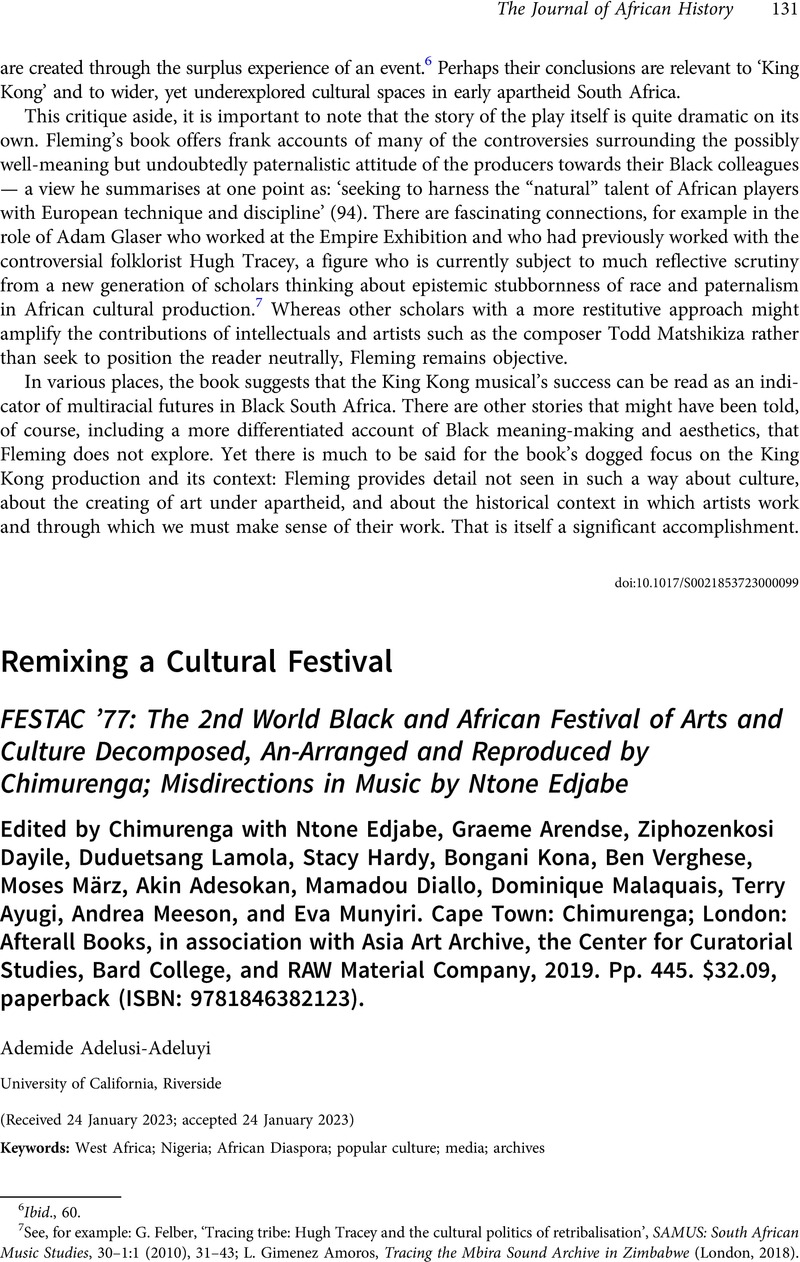No CrossRef data available.
Article contents
Remixing a Cultural Festival - FESTAC ’77: The 2nd World Black and African Festival of Arts and Culture Decomposed, An-Arranged and Reproduced by Chimurenga; Misdirections in Music by Ntone Edjabe Edited by Chimurenga with Ntone Edjabe, Graeme Arendse, Ziphozenkosi Dayile, Duduetsang Lamola, Stacy Hardy, Bongani Kona, Ben Verghese, Moses März, Akin Adesokan, Mamadou Diallo, Dominique Malaquais, Terry Ayugi, Andrea Meeson, and Eva Munyiri. Cape Town: Chimurenga; London: Afterall Books, in association with Asia Art Archive, the Center for Curatorial Studies, Bard College, and RAW Material Company, 2019. Pp. 445. $32.09, paperback (ISBN: 9781846382123).
Review products
Published online by Cambridge University Press: 21 April 2023
Abstract

- Type
- Book Review
- Information
- Copyright
- Copyright © The Author(s), 2023. Published by Cambridge University Press
References
1 See The Chimurenga Chronic: Now-Now, a Pan African Gazette, https://chimurengachronic.co.za/; N. Mabuse, ‘Chimurenga: Africa's answer to the New Yorker’, CNN, 4 June 2012, https://www.cnn.com/2012/06/04/world/africa/ntone-edjabe-chimurenga/index.html; N. Edjabe and U.-S. C. Nzewi, ‘The FESTAC ’77 mixtape’. | MoMA Magazine, 9 Dec. 2020, https://www.moma.org/magazine/articles/471.
2 ‘About the Chimurenga library’, The Chimurenga Chronic, https://chimurengachronic.co.za/about-the-chimurenga-library/.
3 Soyinka's essay entitled ‘Festac agonistes’ features in the volume.
4 Apter, A., The Pan-African Nation: Oil and the Spectacle of Culture in Nigeria (Chicago, 2005)CrossRefGoogle Scholar.
5 Ibid., for more background.
6 ‘FESTAC AT 45: FESTAC ’77, A Mixtape by Chimurenga’, The Chimurenga Chronic, 29 July 2020, https://chimurengachronic.co.za/festac-77-a-mixtape-by-chimurenga/.
7 In the volume, see: W. Soyinka, ‘Festac agonistes’; U.-S. C. Nzewi, ‘Mapping pan-African artistic modernism at FESTAC ‘77’, 150–1; D. Malaquais and C. Vincent, ‘Three takes and a mask’, 53–6.
8 Stanek, Ł., Architecture in Global Socialism: Eastern Europe, West Africa, and the Middle East in the Cold War (Princeton, 2020)Google Scholar.
9 Apter, A., ‘Festac 77: a Black World's Fair’, in Oxford Research Encyclopedia of African History (Oxford, 2021)Google Scholar, https://doi.org/10.1093/acrefore/9780190277734.013.798.
10 Onabanjo, O. C. (ed.), Marilyn Nance: Last Day in Lagos (Johannesburg, 2022)Google Scholar.



